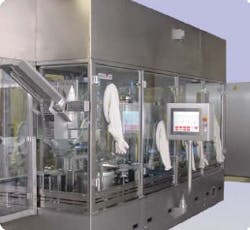The market for oncology-related clinical trials has also grown. Oncology represented 17.8%, or the largest share of clinical trial starts in 2005 (Ibid p. 47). With regard to oncology products in development, anticancer compounds rank first worldwide with 2,467 compounds in development as of March 2006 (Parexel’s Pharmaceutical R&D Statistical Sourcebook 2006/2007, p. 49, IMS Life Cycle R&D Focus).
The increased understanding of the molecular basis of cancer pathology has led to cancer treatments becoming more specialized in terms of targeting molecular pathways. However, because these agents are essentially cytostatic in nature (i.e., they limit cell proliferation but do not result in a decrease in tumor mass), they will continue to be used in combination with traditional cytotoxic agents which will decrease tumor mass, ultimately leaving the patient tumor-free and able to live longer and with a better quality of life.
Currently, cytotoxic products represent about $10 billion of the $37 billion oncology market. Eighty percent, or about $8 billion, comes from three parenterally administered drugs — Eloxatin (oxaliplatin), Taxotare (docetaxel) and Gemzar (gemcitabine) — all of which will become generic by 2014. The global market for cytotoxic products is estimated by Datamonitor to peak in 2009 at about $13 billion, but shrink to about $11 billion in 2014 due to generic price erosion (source: Sarah Terry Johnston, Datamonitor).
Manufacturing Cytotoxic Products
In many cases, cytotoxic agents represent compounds whose exposure limits are as low as 0.03 µg/m3 over eight hours. In order to protect production operators and the surrounding environment from exposure, manufacturing operations typically are performed in barrier isolator systems or closed restricted access barrier systems (cRABS). The use of these systems allows for complete containment of the environment where the product is manipulated.
Within any cRABS or barrier isolator system, the air is HEPA-filtered before being exhausted out of the isolator via a dedicated duct that is directed out of the room. Many advanced isolator systems can both clean and sterilize in place to eliminate the need for disassembly and potential exposure between batches.
In a multi-product facility, disposable tubing/parts are typically used to facilitate quicker batch change-over. However, physical cleaning of the product-contact or product-exposed surfaces is necessary to show absence of the last product before the isolator is opened to the general room environment.
These isolator-based systems allow for not only containment during filling and stoppering but also during formulation/compounding. Further considerations to the flow of personnel, equipment and materials before, during and after manufacturing need to be made in order to ensure proper segregation of “clean” vs. “dirty.” In a normal GMP setting, where traditional parenteral manufacturing occurs, this is critical, but this is even more critical where highly potent, cytotoxic products are manufactured. In addition, this is especially important should the equipment need to be disassembled and taken out of the room for cleaning/sterilization.
Lyophilization
Lyophilization of cytotoxic agents requires additional containment and specialized handling. In the case of manually loaded/unloaded lyophilizers, it is crucial to consider personnel protection from product spill as this could result in the personnel carrying residue into adjacent areas. Separate ingress and egress points with specific degowning areas will, in most cases, ensure residues are not carried into “clean” areas or into the general plant environment. However, manual loading/unloading is becoming less frequent with the advent of more modern and computer-controlled (and robust) loading/unloading systems.
Certain types of these automated systems can be controlled from a separate environment or even remotely from a site external to the plant. This arrangement eliminates the need for operators and thus, the exposure potential.
There are two types of automated loading systems that are currently used. The first is an “in-line” system that essentially feeds the filled/partially stoppered vials one row at a time onto the lyophilizer shelf. The feeding mechanism is usually either a set of vacuum/suction cups that grip the vials or a push bar. The second type is an “accumulation system,” where the vials are accumulated on a station (large flat stainless surface) adjacent to the lyophilizer and loaded with a transfer cart.
Both the in-line and the transfer cart/accumulator systems can be placed in a cRABS or isolator. However, the accumulation system does have several drawbacks. The most important is that if multiple products are to be produced in the manufacturing environment, additional cleaning/sampling would be needed because of the increased surface area exposure compared to the in-line system. This would result in more down time between batches. Further, docking considerations and transfer points are far more critical in the case of an accumulation system in an isolator compared to an in-line system where there are no transfer points between machines.
Generally speaking, lyophilization cycles for cytotoxic agents are no longer than traditional pharmaceuticals. Most cancer therapies are very potent, thus requiring small doses and subsequently, smaller containers. Typically, smaller vials translate into shorter cycle times of less than 48 hours. Lilly’s Gemzar is an exception to this as it is supplied in up to a 1g, 50mL vial. Further, cytotoxics are generally small molecules as opposed to biologic entities/larger molecules (proteins). Larger molecules tend to have longer cycles due to conformational changes many proteins undergo when exposed to the freeze-drying process.
Once loaded and lyophilized however, the same issues persist with both automated and manually loaded systems. These issues include:
- The need for cleaning of the chamber;
- Collection of effluent (condenser ice melt);
- Post lyophilization capture of any powder from breakage/dusting;
- Subsequent exterior vial washing
Cleaning
Cleaning and cleaning validation are essential in ensuring that the internal surfaces of the lyophilizer are free from any residual product. Most modern lyophilizers are equipped with internal spray-ball systems that not only flush the interior surfaces of the chamber with hot water for injection, but also in some cases, can be equipped to use in a variety of solvents. Flammable solvents, however, would require substantial investment in explosion-proofing the chamber and associated electrical wiring/connections.
The keys to a successful cleaning validation and removal of any product residue are spray-ball pattern (most modern spray-balls rotate when in operation, but they can be fixed as well), water pressure (flow) and time. The pressure is typically restricted by the feed water and plant water for injection capacity. Any consideration to the water consumption needs to be well thought through in the context of the entire system including supporting systems such as heat exchangers, recirculation valves and the percent recirculated versus fresh water.
Collection of the effluent or condenser ice melt can be accomplished with holding tanks or pre-treatment systems. These systems typically use caustic (sodium hydroxide) with pH adjustment prior to emission to the wastewater stream. In most cases, the high pH will degrade any product residue and take away any toxic effects the effluent may have on the flora of the sewage system. Careful consideration should be given to the mix of products and their degradation potential, as some products may not degrade under alkaline conditions and may require alternative treatment options. Finally, breakage does occur from time to time even in the most robust lyophilizers. This can produce residue that can accumulate on the exterior surfaces of the remaining unbroken vials in the chamber.
Once the vials are stoppered in the chamber, there is no issue with the now-dried product in the stoppered vials as they exit the lyophilizer into the capping area, but the external surfaces of the vials should be cleaned before general use handling. This is mainly accomplished with an external vial washer placed in the equipment train post capping (after the vials are sealed). In addition, this system typically is in an isolator, where a fine mist of purified water is sprayed on the vials as they exit the manufacturing line into general-use packaging areas. Just as in the lyophilizer, collection of the effluent of this phase of the manufacturing process is important to ensure product collected in the waste water is appropriately treated before release to the sanitary sewer system.
Vial Wrapping
One last consideration is the use of exterior vial wrapping to avoid product exposure if a vial is broken in general use. This typically is accomplished by shrink wrapping the entire vial with a film so that if a vial is dropped, the glass is less likely to break. Different types of shrink wrapping are available, but the use of heat is not recommended for product stability purposes. Many systems employ the use of vacuum shrink wrapping post vial inspection to accomplish this.
Manufacturing Cytotoxic and Non-cytotoxic Products
Although many in the industry may disagree, it is possible to manufacture cytotoxic products and non-cytotoxic products in the same manufacturing environment, as long as proper engineering and procedural controls are in place. Guidance from the UK Medicines Control Agency (MCA Rules and Guidance for Pharmaceutical Manufacturers and Distributors, 2002, pg. 213, sec. 4.41) indicates that dedicated areas should be considered for these types of agents, unless appropriately validated inactivation or cleaning procedures are established and maintained.
Additional controls could include:
- maintaining dedicated product contact parts such as tanks, filling needles and filter housings;
- using disposable tubing; and
- ensuring that the surfaces of the process equipment are free of any cytotoxic materials before introducing the next product (cytotoxic or not), which is important in a multi-product equipment train.
This could be done through cleaning automatically, as is the case with isolators with integrated spray-ball systems (the same is true for freeze-dryers) or even manual cleaning of these surfaces with swab sampling of areas where product is made or is likely to make contact with stainless steel, Lexan, or rubberized parts/surfaces.
Only after appropriate limits are set, validations are performed, specificity is established and recovery studies are conducted should the data generated be reviewed and approved by the QC/QA group and the equipment released for further use. Without the proper engineering controls, however, the manufacture of cytotoxic or highly potent compounds presents significant risk to production operators, or in the case of a multi-product facility, other products.
In many cases, pharmaceutical companies have chosen to build dedicated assets for cytotoxic manufacturing to avoid the validation and batch change-over inefficiency to ensure proper segregation is in place. This decision can be strictly financial in nature and not a compliance-based decision. The most important consideration in a multi-use production line is to know up-front the likelihood of potent/cytotoxic product use. With this knowledge, one can design the manufacturing line to accommodate the necessary engineering controls to handle cytotoxic products and allow for quick change-overs and disposable product contact systems so non-cytotoxic products can be produced in the same environment. In the end, operator safety is paramount, no matter which direction a company may take.
Cytotoxic Market Outlook
In conclusion, parenteral manufacturing of cytotoxic products presents a number of challenges but also some opportunities. Although the overall market is expected to decrease as generic price erosion will drive some losses in market size by 2014 from a dollars perspective, unit production volumes will increase worldwide as more companies enter the market with generic alternatives and more affordable options are available to those patients in need. However, even in light of the branded product weakness in the 5- to 7-year horizon, there is the potential that several new compounds may enter the market, based on the number of products in the drug development pipeline.
The development of new compounds, coupled with the growth of cytostatic products (and the need for companion cytotoxic products) and the increase in life expectancy in developed countries, will drive growth/demand for parenterally administered cytotoxic products over the next 10-20 years. With parenteral cytotoxic manufacturing capacity currently a specialized area because of the containment required, branded, generic and contract manufacturing companies will all need to assess the production volume requirements for cytotoxic products in the coming years to ensure there is adequate supply of these critical products for cancer therapy. Investment in the proper engineering controls is necessary to ensure operator safety and compliance with regulatory expectations.
About the Author
Prior to joining AAI Pharma, he served as a consultant for pharmaceutical and biotechnology companies in the areas of technical operations, FDA compliance, supply chain operations and strategic planning. Before that, he was vice president of contract services for Baxter Healthcare Corp., where he directed the design, development and operation of more than $250 million in manufacturing assets in support of one of the world's largest contract manufacturing businesses. Previously, he was Baxter's vice president of operations. He can be reached at [email protected].







